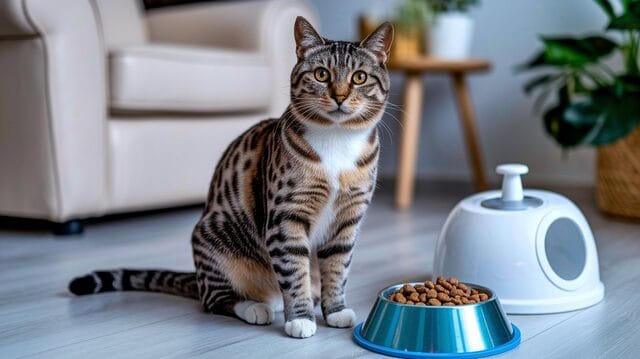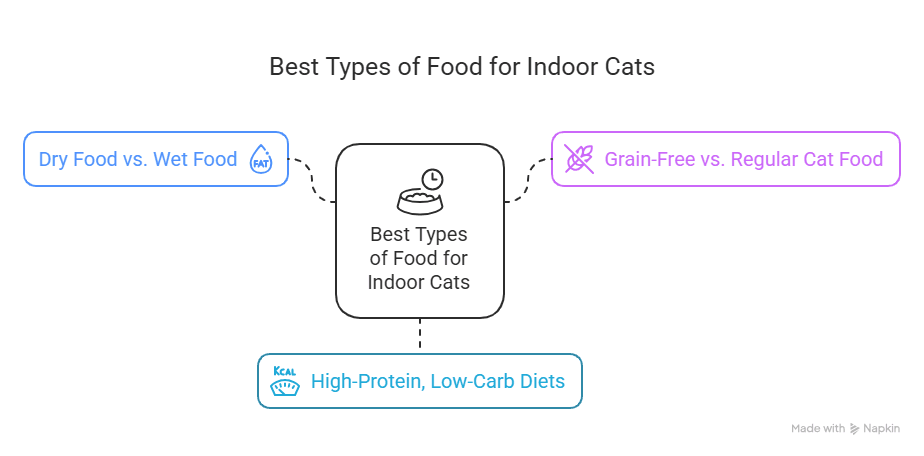
Introduction
If you’re a proud indoor cat parent, you probably already know that keeping your feline friend happy and healthy goes beyond just playtime and cozy beds. One of the most important aspects of caring for an indoor cat is feeding them the right diet. Since indoor cats have a more sedentary lifestyle compared to their outdoor counterparts, it’s essential to focus on the best diet for indoor cats to support their overall health and well-being.
A poor diet can lead to obesity, digestive issues, and even long-term health problems like diabetes and kidney disease. So, what exactly should you be feeding your indoor cat? In this guide, we’ll break down the best diet choices, common mistakes, and how to ensure your cat is getting the nutrients they need.
Understanding an Indoor Cat’s Nutritional Needs
Indoor cats have different dietary needs than their outdoor counterparts. Since they don’t have the opportunity to hunt for prey or get as much exercise, their diet should be nutrient-dense but controlled in calories to prevent weight gain.
Here are the key nutrients every cat needs:
- Protein – Cats are obligate carnivores, meaning their diet must be primarily made up of animal-based protein. Look for cat food with real meat (chicken, turkey, beef, fish) listed as the first ingredient.
- Fats – Healthy fats like omega-3 and omega-6 fatty acids are essential for a shiny coat, healthy skin, and overall well-being.
- Fiber – Helps with digestion and prevents hairball buildup, which is common in indoor cats.
- Taurine – A crucial amino acid that supports heart and eye health. Unlike humans, cats cannot produce taurine on their own, so it must come from their food.
- Vitamins & Minerals – Calcium, phosphorus, and vitamins A, D, and E are essential for bone health, vision, and immune function.
Since indoor cats burn fewer calories, their diet should also be low in carbohydrates and rich in protein to maintain muscle mass and avoid excessive weight gain.
Best Types of Food for Indoor Cats

Now that we know what nutrients your cat needs, let’s talk about the best food choices.
1. Dry Food vs. Wet Food: Which is Better?
- Dry food (kibble) is convenient, affordable, and helps with dental health. However, it often contains more carbohydrates and less moisture, which can lead to weight gain and urinary issues.
- Wet food (canned food) is higher in protein and moisture, which is great for hydration and kidney health. However, it can be pricier and spoils faster once opened.
Best option? A combination of both is ideal! Feed wet food for hydration and protein, and supplement with dry food for variety and dental benefits.
2. Grain-Free vs. Regular Cat Food
Many pet food brands advertise grain-free diets as the best option, but this isn’t always necessary. Cats do not need grains, but they also aren’t inherently bad unless your cat has an allergy or digestive issue. More important than grains is ensuring your cat’s food is high in animal protein and low in fillers like corn, wheat, and soy.
3. High-Protein, Low-Carb Diets for Indoor Cats
Since indoor cats have a lower activity level, they should eat a diet that is high in protein and lower in carbohydrates to maintain muscle and prevent obesity. Look for food with at least 30-40% protein and minimal fillers.
Common Dietary Mistakes Cat Owners Make
Even with the best intentions, cat owners sometimes make dietary mistakes that can negatively affect their feline’s health. Here are the most common ones to avoid:
1. Overfeeding and Obesity
Indoor cats are prone to obesity due to their lack of activity. Many owners overestimate how much food their cat needs. Always follow portion guidelines based on your cat’s weight and consult your vet if unsure.
2. Choosing Food Based on Marketing, Not Ingredients
Many commercial cat foods use fancy marketing terms like “natural,” “premium,” or “healthy,” but the ingredient list is what really matters. Avoid foods that list corn, by-products, or artificial additives as the main ingredients.
3. Ignoring Hydration
Cats don’t naturally drink a lot of water, so hydration is crucial, especially for those on a dry food diet. Provide fresh water daily, and consider a cat water fountain to encourage drinking.
Special Diets for Indoor Cats
Some cats need specialized diets based on their age, health, or weight.
- Kittens need food high in protein and fat for growth.
- Senior cats may need lower-calorie food with joint-supporting ingredients.
- Cats with allergies may need limited-ingredient diets.
- Overweight cats should be on high-protein, portion-controlled diets to help with weight loss.
Always check with your vet before switching your cat’s diet, especially if they have medical conditions.
How to Transition Your Cat to a Healthier Diet
Switching your cat’s food too quickly can lead to digestive upset. Follow this step-by-step transition guide:
1. Days 1-2: Mix 75% old food with 25% new food.
2. Days 3-4: Adjust to 50% old food, 50% new food.
3. Days 5-6: Increase to 75% new food, 25% old food.
4. Day 7 and beyond: Fully switch to the new diet.
Watch for signs like vomiting, diarrhea, or refusal to eat, and slow down the transition if needed.
FAQs
1. How much should I feed my indoor cat?
It depends on their weight and activity level, but generally ¼ to ½ cup of dry food per day or one small can of wet food is appropriate. Always check your cat food’s feeding guidelines.
2. Can indoor cats eat raw food diets?
Yes, but raw diets require careful preparation to ensure they are nutritionally balanced. Consult your vet before switching to raw food.
3. What human foods are safe for cats?
Small amounts of cooked chicken, fish, eggs, or plain pumpkin are safe. Avoid chocolate, onions, garlic, and dairy.
4. How do I know if my cat has food allergies?
Common signs include itching, vomiting, diarrhea, or excessive grooming. Consult a vet to determine the cause.
5. Is homemade cat food a good option?
It can be, but homemade diets must be nutritionally complete. Work with a veterinary nutritionist if considering this option.
Also Read - How to Prevent Hairballs in Cats? Causes, Remedies & Expert Tips
Conclusion
Feeding your indoor cat the right diet is key to keeping them healthy, active, and happy. Prioritize high-protein, low-carb foods, avoid overfeeding, and ensure they’re staying hydrated. By making informed choices, you can help your cat live a long and healthy life!




